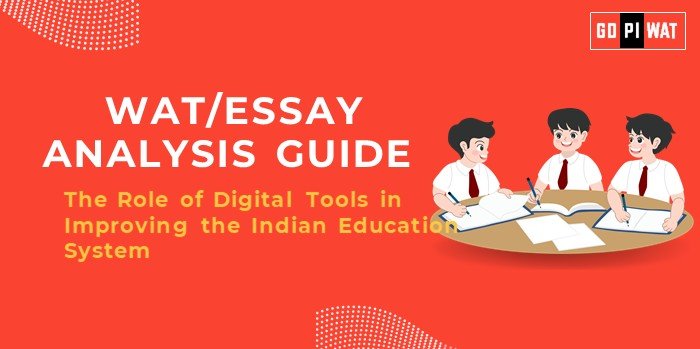📋 The Role of Digital Tools in Improving the Indian Education System
🌐 Written Ability Test (WAT) / Essay Analysis Guide
💡 Understanding the Importance
Digital tools are a transformative force for aligning India’s education system with global standards. From enhancing learning quality to addressing accessibility challenges, technology can bridge the socio-economic barriers hindering educational equity in India.
⏳ Effective Planning and Writing
- 🕒 Time Allocation:
- 📋 Planning: 5 minutes
- ✍️ Writing: 20 minutes
- 🔍 Review: 5 minutes
- 📌 Preparation Tips:
- 📱 Use success stories like BYJU’s and Khan Academy for EdTech advancements.
- 🏛️ Highlight government initiatives like PMGDISHA (Pradhan Mantri Gramin Digital Saksharta Abhiyan) for rural outreach.
💬 Introduction Techniques
- ⚖️ Contrast Approach: “While urban schools benefit from smart classrooms and digital content, many rural institutions lack basic internet connectivity, reflecting stark disparities.”
- 🛠️ Solution-Oriented Approach: “Integrating digital tools into India’s education system can unlock quality learning, making education inclusive and accessible for all.”
📊 Structuring the Essay Body
🏆 Achievements:
- 📱 EdTech Growth: Platforms like BYJU’s and Vedantu are democratizing access to quality education.
- 🌐 Digital Literacy Programs: Initiatives like PMGDISHA have made significant strides in rural digital adoption.
- 🎓 Enhanced Learning Outcomes: Blended learning models combine traditional methods with online platforms for better results.
⚠️ Challenges:
- 🏚️ Rural-Urban Divide: Only 27% of rural households have internet access, limiting digital adoption.
- 👩🏫 Teacher Training Gaps: Many educators lack the digital literacy required to effectively use digital tools.
- 💻 Device Affordability: High costs of devices and internet remain a challenge for underprivileged communities.
🚀 Future Outlook:
- 🤖 AI Integration: Use of AI-powered platforms for personalized learning and real-time progress tracking.
- 🏛️ Public-Private Partnerships: Collaboration between the government and EdTech companies to ensure widespread access to digital tools.
- 📶 Connectivity Expansion: Investment in rural infrastructure to bridge the digital divide.
✅ Concluding Effectively
- ⚖️ Balanced Perspective: “Digital tools hold immense potential to revolutionize Indian education, but their success requires robust infrastructure and policy support to ensure inclusivity.”
- 🌍 Future-Oriented Conclusion: “The future of Indian education lies in blending technology with accessibility, ensuring every child, rural or urban, benefits from the digital revolution.”
📚 Analyzing Successes and Shortcomings
- 🏆 Key Achievements: Growth in EdTech platforms, improved digital literacy, and hybrid learning models.
- ⚠️ Ongoing Challenges: Limited internet penetration, affordability of devices, and uneven teacher preparedness.
- 🌍 Global Context: Countries like China and the USA have successfully adopted AI-driven education systems to enhance learning outcomes.
🛠️ Recommendations for Sustainable Progress
- 📚 Blended Learning Models: Integrate traditional teaching with digital tools to improve inclusivity.
- 👩🏫 Teacher Training: Launch nationwide programs to upskill educators in digital pedagogy.
- 🤝 Public-Private Partnerships: Encourage EdTech companies to collaborate with schools for affordable and scalable digital solutions.
📝 Sample Short Essays
🔹 Balanced Perspective:
“Digital tools offer immense promise for transforming India’s education system by enhancing accessibility and quality. However, addressing challenges like internet access and teacher training is crucial to ensure equitable progress. A balanced approach can empower every student to benefit from technology’s vast potential.”
🔹 Solution-Oriented:
“India can bridge its educational gaps by implementing blended learning models, strengthening digital literacy among teachers, and expanding public-private partnerships. With these measures, digital tools can create a future-ready education system that is inclusive and globally competitive.”
🔹 Global Comparison:
“Countries like China have integrated AI-powered tools into classrooms, enhancing learning efficiency. India, with its vast student population, must adopt similar strategies while focusing on affordability and infrastructure to ensure digital education reaches every corner of the country.”
📌 Key Takeaways
- 🚀 Digital tools enhance learning outcomes, increase accessibility, and foster inclusivity.
- ⚠️ Challenges like internet penetration and teacher training must be addressed for sustainable progress.
- 🌍 By adopting global best practices and investing in infrastructure, India can revolutionize its education system for future generations.


